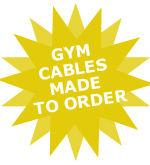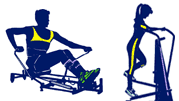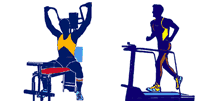|
HOW TO MOVE A HOME GYM
If you plan to move a home gym, for safety reasons,
you should have at least two able bodied people to do the job. Even though
you may be thoroughly familiar with the structure of the gym and how the
frame parts go together, even if you have the gym’s assembly instructions, take several pictures from different angles, being careful to get clear views of the gym cable routings. Be sure that the pictures show whether the cables go over or under each of the gym’s pulleys. A little extra effort at this point of the gym’s disassembly can save a lot of grief during the gym’s
reassembly, which might not be for several weeks or even months.
Begin by removing all of the gym attachments, such
as, lat bars, triceps ropes, ab straps, ankle straps, chains, weight selection
pins, etc. and weight stack shrouds or protective shields and put them aside
where no one will trip over them. The goal is to disassemble the home gym
to the point where the frame pieces are small enough to fit easily through
the smallest doorway that they will have to pass through and be light enough
to be moved safely. Tie down any parts that pivot, like pec deck movement
arms, leg curl, leg extension pieces or anything similar to keep them from
swinging around when the pieces are actually moved to avoid scraping walls
or injuries, like pinched fingers.
The next step is to remove the weight stacks. Start by disconnecting the cable from the selector rod or top plate of the weight stack. Tape the cable to a convenient frame piece out of your way, as much as possible; you may have to move it later when the gym's frame is taken apart. Caution, weight stacks are heavy and once loosened from the frame, it may require two people to stabilize it. With that in mind, disconnect the weight stack guide rods (the two steel shafts that the weight plates ride up and down on ) at their tops where they attach to the frame. Note, each brand and model of home gym employs a different method of keeping the tops of the guide rods in place. The important consideration is that once they are loose, most weight stacks are unstable and can tip or fall out of the frame. Be prepared for sudden weight shifts of the stack. Once the guide rods are loosened, starting with the top weight plate, lift it up and over the top of the guide rods and hand it to someone to stack on the floor, out of the way. Continue the process, removing one weight plate at a time, until the guide rods are empty. Limit these temporary stacks to two or three plates each. When the guide rods are empty, remove the pair of guide rods from the base of the gym’s
frame. If the gym has more than one weight stack, repeat the procedure for
each of the other weight stacks.
When all of the weight stacks have been removed from the gym, step back and study the gym’s frame. It is not necessary to take apart every last piece of the frame. Look for points on the top and bottom of the frame where the frame bolts can be removed in a few places, that will leave manageable sections of the gym’s framework intact. Once that has been decided, be sure that the cables are taped to the correct sections of the frame and that no cable are allowed to flop around. Secure the gym cables at both ends if necessary, only removing the cables from the gym’s
pulleys where you need to in order to be able to separate the frame pieces.
Break down the frame much as necessary to handle the pieces safely. When
removing frame bolts, put them back in the holes from which they were extracted,
along with their respective washer, lock washers and nuts as soon as the
frame pieces have been separated enough to do so. This will keep any of the
frame bolts and hardware from getting lost or later being installed in the
wrong places.
Never transport the weight plates while they are on the guide rods. Doing so can bend the guide rods and cause the weight plate bushings to detach. At this point the frame sections, the weight plates, weight selection keys and the gym attachments can be relocated to the new site. Be careful not to damage any of the gym’s
upholstery.
When all of the gym’s components are at the new site,
choose a location for the gym, decide which way you want the gym to face
and be sure to allow enough room to allow for the maximum extension of the
gyms movement arms and enough additional room for safe passage. Don't forget
to consider the maximum height of the gym, an often over looked dimension.
To reassemble the home gym, after inspecting the gym's main frame pieces
for shipping damage, just reverse the procedures that you followed when you
disassembled the unit. Before using any positions on the gym, be certain
that the cables are securely fastened to the weight stack selector rods,
top plates or other anchoring points. Double check the cable routing, observe
that all of the gym cables are seated properly in their pulleys and not binding
on any cable guides or frame pieces. Install the gym attachments and test
each position with no extra weight plates attached to the selector rods.
All of the cables should move freely. If not, find the cause and correct
the trouble. Insert the weight selector pins and repeat the tests with a
few plates attached. When testing the various gym positions, use caution;
for example, do not pull the lat bar toward your face incase the lat cable
comes loose. If you are satisfied that everything is working properly, try
each position with heavier loads.
If all checks out well, your relocation is complete,
but before allowing family members to use it, it is advisable to have preventive
maintenance done on your home gym by a qualified fitness equipment service
company to be sure that it is safe to use.
|

 |





